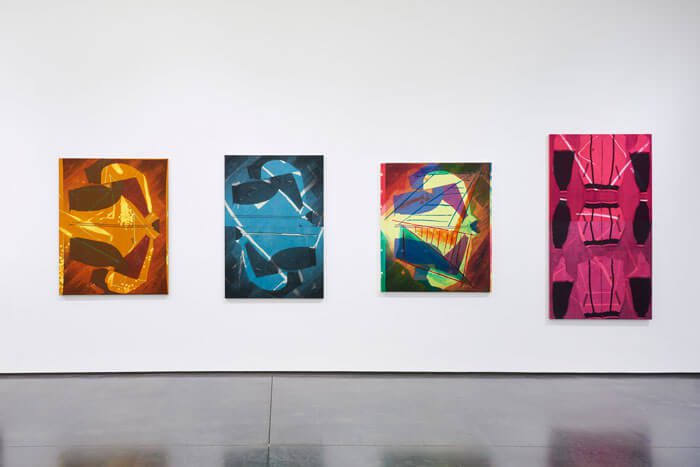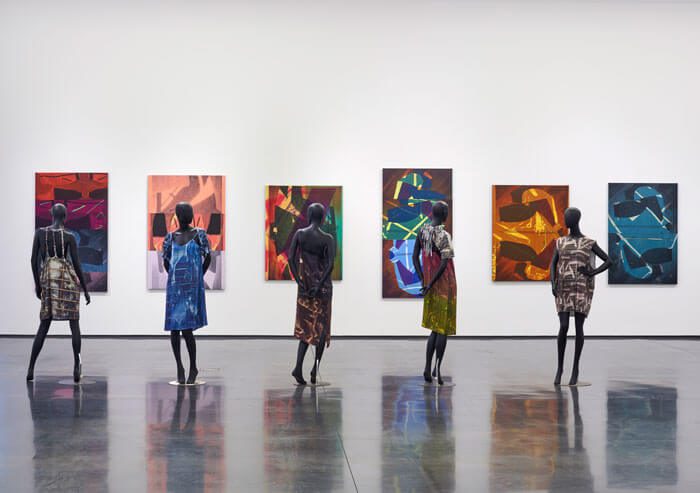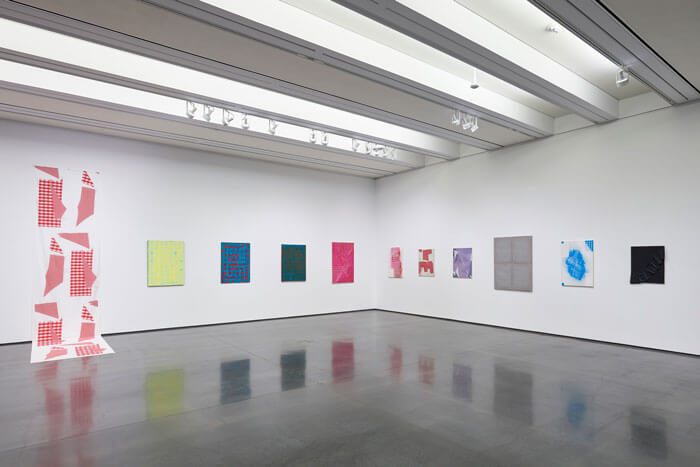
Aspen Art Museum, Aspen, CO
June 29–December 16, 2018
Cheryl Donegan’s GRLZ + VEILS, curated by Heidi Zuckerman and Bill Arning, comes on the heels of recent surveys at the New Museum and Kunsthalle Zürich that worked to thread together narratives of Donegan’s video work and painting practice. Donegan gained notoriety for her unabashedly erotic video work in the early ’90s that in some ways impeded her audience’s understanding of her painting, which is now, finally, receiving major attention.
Donegan’s work is feminist, irreverent, and grounded in street style and pattern. Like the layered visual communication of bodegas, dollar stores, and fabric stores, her paintings give an impression of bright colors all piled onto one another, competing for your attention. This is most immediately found in an L-shaped installation of mannequins, featuring a new collection by Donegan, GRLZ Upcycle, 2018. Drug Hoodie in Inkhead bears the image of a tagged metal grille of an a/c unit digitally printed on fabric. Truth be told, I was curious to see how her aesthetic would read in the hyper-wealthy bubble of Aspen, Colorado. Would the work lose its high/low edge of garish, clashing, electric palettes in the Roaring Fork Valley’s hub of private jets and manicured public spaces? What Aspen lacks in a socioeconomic spectrum, it makes up for as a natural setting. The natural surroundings provide a foil to the synthetic color dialogues and quotidian details of GRLZ + VEILS.

Unlike the video-heavy Kunsthalle Zürich show, Zuckerman and Arning organized a highly selective painting survey of works since 2010 and open the door to intersections of fashion, daily life, retail aesthetics, and mark-making in Donegan’s studio practice. The gingham pattern in a number of Donegan’s paintings, which she lifts from Rei Kawakubo of Comme des Garçons, elevates the gingham with harnessed energies of duality. Always two-toned, sometimes high-contrast—think milky turquoise and scarlet red or low-key mauve and subdued pink—Donegan’s works take gingham’s grid and its nostalgic baggage and apply them mechanically to the rough, wiry surface of jute canvas. Stencils, tape, and spray applications remove visible signs of her hand from the painting. Jute, more often used for bagging potatoes and grains than for clothing, is elevated by a pattern overlay typically woven into linen. It’s important to note that Donegan works in series to push the internal logic of her paintings forward. The gingham overlays, snaps, disrupts, fades, and bends in each painting, and you can feel the speedy twitch of tempo. Donegan is impatient, rigorous, and ruthless with the work, and you feel the rush. These are the works that made it out of the studio, the ones that click.
The show will travel to the Contemporary Arts Museum, Houston, with an additional focus on Donegan’s video work from the past decade. I imagine the spirit of the work will hum with a greater intensity when back in a culturally rich, densely populated, urban setting. My recommendation: initial walkthrough, read Zuckerman’s studio interview with Donegan over coffee on the rooftop café, and then go back in for a second round. Spoiler alert: Donegan references Rem Koolhaas’s critique of contemporary urbanism, Junkspace.





